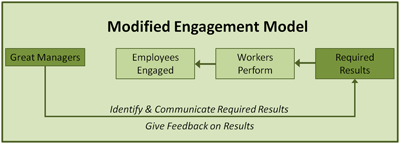"Leadership Matters"
— A Management Newsletter —

Inspiring Employee Engagement
All managers want greater employee
engagement. We realize that there is a tremendous difference between
motivated commitment and mere compliance, and that the difference
impacts everything from day-to-day employee satisfaction to ultimate
business results — and everything in between.
An exhaustive workplace study by Gallup1 revealed that
only 30% of people in the workforce are fully engaged at work, and
that 20% are actively disengaged. The conclusion drawn by the
authors is that the single most important variable influencing
employee engagement is the immediate boss. In other words, bad
management is the main cause for lack of engagement that leads to
poorer results in areas like productivity, customer ratings, quality
and profitability.
Also from Gallup’s findings, the 25% best-managed teams delivered
significantly better results than the bottom 25%: 50% fewer
accidents and 41% fewer quality defects. Gallup estimates that
disengagement costs companies $500 billion per year. Furthermore,
the top teams generated much lower healthcare costs; so...bad
managers also cause bad health!
We agree with the conclusion that bad managers are the cause of a
lot of these ills, and that management makes a big difference—not
only in the results people get, but also in their lives. But what to
do about it? How do companies overcome a dearth of good managers?
"The single most important
variable influencing employee engagement is the immediate boss."
First, let’s look more closely at Gallup’s survey. The workforce
study has been conducted by Gallup since 2000 and is based on its
Q12 instrument developed in the 1990s. The assessment has focused on
12 questions derived from extensive testing to serve as indicators
for engagement. Interestingly, these questions tend to target
factors that are established intrinsic motivators, such as: autonomy
(“at work my opinions seem to count”), purpose (“the purpose of my
company makes me feel my job is important”), chance to use skills
(“have the opportunity to do what I do best every day”), chance to
develop (“had opportunities at work to learn and grow”), be part of
a winning team (“my associates or fellow employees are committed to
doing quality work”), and clear expectations (“I know what is
expected of me at work”). It is worth noting that only one of the
twelve questions asks specifically about recognition and praise.
Much management literature recommends that managers focus on
increasing engagement by working to “emotionally engage” their
employees and to find ways to engage with each employee. Thus,
engagement surveys are a popular tool of human resource departments.
To the degree that engagement serves as a proxy for good management,
Gallup’s Q12 survey may indeed be a good tool to use, and engagement
may be a valid metric. But it can also mislead the manager from the
primary job of driving great results. A common approach for
achieving engagement is shown in diagram below.
Specifically, the assumption
goes, managers should first engage employees emotionally
so that they perform at a high level in order to achieve results.

This approach, however, focuses the manager's attention on trying to
engage employees directly, which can lead to all kinds of mischief
that distracts both the manager and the employee from the work and
its desired results. An alternative model is depicted in the next
diagram. Here the manager focuses first on the required results in
planning, assigning, organizing and monitoring the work. That is,
the manager is focused on identifying and communicating the required
results through policies that give clear outcomes, then providing
feedback on progress towards those outcomes.
Performance is owned by the
individual, and engagement is a consequence of the manager
effectively focusing employees on the work,
organizing them effectively, and giving them feedback on results so
that they can adjust and improve their performance as needed.

In fact, Gallup’s survey questions echo this focus — provide
employees purpose, give them big jobs under the guidance of policy,
and provide opportunities for mastery. To the degree that managers
do THESE things well, high levels of engagement will follow.
Jim Clifton, the CEO of Gallup concludes his opening letter to the
report, “Let's get rid of managers from hell, double the number of
great managers [and] everything will change.” The report itself
calls for companies to select the right managers, “treat these roles
as unique with distinct functional demands that require a specific
talent set.”
Fortunately, effective management that leads to greater
engagement is something that can be learned — and perhaps
more than a "talent set," it requires a distinct “skill set.” This
calls for management development for those in charge. Improve
management effectiveness, and highly motivated, engaged employees
will surely follow.
_______________________________________________________________________________________________
1"State of the American
Workplace: Employee Engagement Insights for U.S. Business Leaders."
2013 by Gallup.
http://www.gallup.com/services/176708/state-american-workplace.aspx
Click here to SUBSCRIBE to "Leadership Matters" free of charge. Just type "SUBSCRIBE" in the message area, and include your contact info. *We never share our lists. We will email you when we publish a new issue of "Leadership Matters" and you can easily unsubscribe at any time.
| "Outstanding content delivery. Very inspiring, applicable and immediately useful at work." |
| Curt
Hassler Global Licensing Manager DuPont Clean Technologiess |
